THE
FALL OF TROY
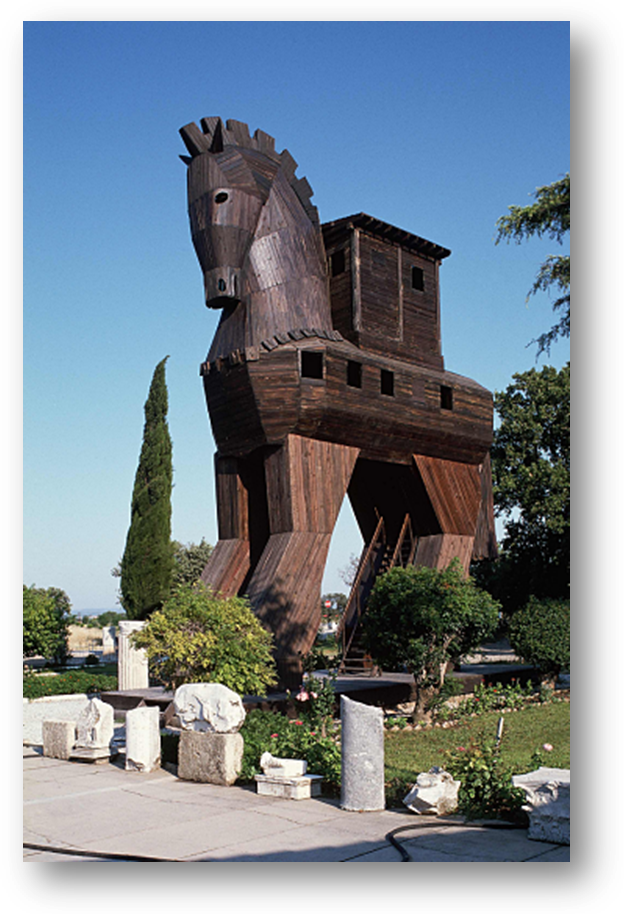
Unit Overview
This
part of the story of the Trojan War comes from Virgilís Aeneid, since Homerís Iliad
ended with Hectorís funeral.† Remember
that the Trojan War had been going on for nine years.† Troy just suffered a great lost with the
death of Hector.
Achilles
With
Hector dead, Achilles knew that his death was not far behind.† His mother had told him that it was his fate
to die soon after Hector.† Before his
death, he completed one last feat of arms.†
Prince Memnon of Ethiopia had come to the assistance of Troy and brought
with him a large army.† For some time,
the Greeks were hard pressed to fight with this new group of warriors, and many
Greek warriors died as a result.†
Finally, Achilles killed Memnon in a glorious battle.† This was Achillesí last battle.† He had driven the Trojans before him up to
the city wall of Troy.† Paris then shot
an arrow at Achilles.† Apollo guided this
arrow so that it struck Achilles in the foot in the one spot where he could be
wounded.†
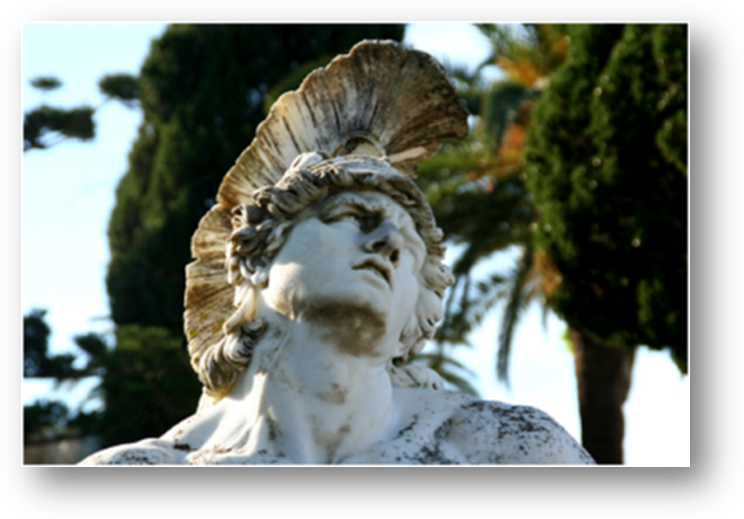
Achilles
When
Achilles was born, Thetis had intended to make him invulnerable.† She dipped him into the River Styx.† In doing so, she was careless because she did
not make sure that the water covered the part of Achilles where she was holding
him.† This part of his body was the area
at the back of his foot and ankle.† So,
when Paris shot the arrow at Achilles, Apollo made sure the arrow struck him in
this region.† Achilles died, and Ajax carried
his body out of the battle while Odysseus held the Trojans back.† After Achillesí body was burned on a funeral
pyre, his bones were buried in the same urn that held the bones of his friend,
Patroclus.
The
armor that Thetis had presented Achilles with before his battle with Hector
caused the death of Ajax.† It was decided
in an assembly that the armor should go to Ajax and Odysseus.† A secret vote was taken between the two of
them, and it was decided that Odysseus would take the armor.† This was a serious matter.† It meant that Odysseus should be honored and
the man who was defeated in this vote would be dishonored.† Ajax saw himself as disgraced.† In a fit of anger, he was determined to kill
Agamemnon and Menelaus.† He believed that
they had turned the vote against him.†
At
night, Ajax went to find Agamemnon and Menelaus.† When he approached their tents, Athena sent
him into a fit of madness.† He tore
through the flocks of sheep the Greeks had with them.† He thought he was slaying Agamemnon and
Menelaus.† Instead, he was killing sheep.
When he realized what he had done, he was ashamed.† He felt that everyone was looking down on
him.† He was embarrassed about losing the
vote for the armor and he was even more upset that he had brought about the deaths
of the animals for no apparent reason other than he had temporarily lost his
mind.† Ajax then drew his sword and
killed himself.† The Greeks did not
provide him with a funeral pyre.† They
believed that a suicide death would not be honored with a pyre.† Instead, they buried him.
Philoctetes
The
death of Ajax following so quickly after the death of Achilles dismayed the
Greeks.† The prophet Calchas told them
that he had no message for them from the gods but that there was a man among
the Trojans who knew the future.† This
manís name was Helenus.† If they captured
him, they could find out what they should do.†
Odysseus captured him and he told the Greeks that Troy would not fall
until someone fought against the Trojans with the bow and arrow of
Hercules.† When Hercules died, the bow
and arrow were given to Philoctetes.†
Philoctetes had been with the Greeks earlier in their travels to Troy.
On
the voyage, the Greeks stopped at an island to offer a sacrifice.† Philoctetes was bitten by a serpent.† It was a bad wound and it would not heal.† It was impossible to take him to Troy with
them; the Army couldnít wait.† They left
him at Lemnos.† Lemnos was uninhabited at
that time, but it was the island in the story of the Quest for the Golden
Fleece that was inhabited by women.
It
was cruel to leave a wounded man on a deserted island, but they were desperate
to get to Troy.† With his bow and arrow,
he would be able to provide himself with food.†
When the Greeks learned that they would need a favor from Philoctetes,
they thought it would be impossible to get the bow and arrow from him. †Surely he was still upset for being
abandoned.† They sent Odysseus to
Philoctetes.† The Greeks knew that
Odysseus was smart enough to get the bow and arrow by trickery.† Odysseus succeeded in gaining the bow and
arrows and in persuading Philoctetes to regain the Greek army.† In Troy, the Greek physician was able to heal
him.† The first man he wounded in battle
was Paris.†
As
Paris fell, he begged to be taken to Oenone, the nymph he had lived with on
Mount Ida before he made his judgment.†
Oenone had told him that she knew of a magic drug to cure any
ailment.† They took Paris to Oenone but
she refused.† She could not forgive him
for leaving her for another woman.† She
watched him die and then killed herself.
Taking Troy by Surprise
Troy
did not fall because of Parisí death.† He
was no great loss to the city.† The
Greeks learned that there was a sacred image of Athena called the Palladium in
the city.† As long as it was in Troy, the
city could not be taken.† Odysseus and
Diomedes were determined to steal the Palladium.† Diomedes was the one who bore the image
off.† One dark night, Diomedes climbed
the wall of Troy with help from Odysseus.†
He found the Palladium and returned to the Greek camp with it.† With this great encouragement, the Greeks
were determined to wait no longer, but they needed to devise a way to put an
end to the war.
The
only way they could get their army into Troy was by surprise.† It had been almost ten years since the war
began.† The city walls were still
uninjured.† They had never suffered a
real attack.† The fighting had taken
place, for the most part, at a distance from them.† The Greeks had to find a secret way of
entering the city.† The new strategy was to
build a wooden horse.† This was Odysseusí
idea.
Odysseus
had a skilled woodworker make a large wooden horse.† It was hollow inside and so big that it could
hold a large number of men.† Odysseus
then persuaded the army to hide inside of the horse.† The plan was that the other Greeks would
pretend to go out to sea.† Instead, they
would hide beyond the nearest island where they would not be seen by the
Trojans.† Whatever happened, they would
be safe.† They could sail away if
anything went wrong.† If something went
wrong, though, the men in the horse would surely die.
Odysseusí
plan included leaving one man behind in the Greek camp.† This man would have a story to tell the
Trojans that would make them want to bring the horse into the city.† Then, when the night was the darkest, the
Greeks would leave the horse and open the city gates to the Greeks who were
waiting in their ships.†
On
the day that the plan was put in place, the Trojan watchers saw two amazing
sights.† In front of the gates stood a
large wooden horse.† It was so strange to
them because they had never seen anything like it.† The noisy Greek camp was deserted and their
ships were gone.† They had given up and
set sail for Greece.† The city of Troy
rejoiced.
The
people flocked to the camp to see for themselves what the Greeks had left.† Once they had taken in the vast emptiness
that had been the camp, they returned to the city gates to look at the large
horse.† The Greek who had been left
behind revealed himself to the Trojans.†
This manís name was Sinon.† He was
seized by Priam.† Sinon was weeping and
protesting, saying that he no longer wanted to be a Greek.†† He told the story Odysseus instructed him to
tell.†
The
story Sinon told was that after stealing the Palladium, Athena was very upset
with the Greeks.† When they went to the
oracle to ask how to amend the situation, the oracle said a Greek needed to be
sacrificed in order to make things right.†
Sinon was the individual chosen to be sacrificed.† Everything was ready for the sacrifice, but
right before it began Sinon escaped and hid in a swamp.† He watched the ships sail away.
It
was a good story and the Trojans never questioned it.† They pitied Sinon and assured him that he
could now live among them.† So, it was
with a brilliant plan and trickery that the city of Troy was conquered, not
with violence.† Sinon did not forget the second
part of the story.† This part of the
story involved the horse.
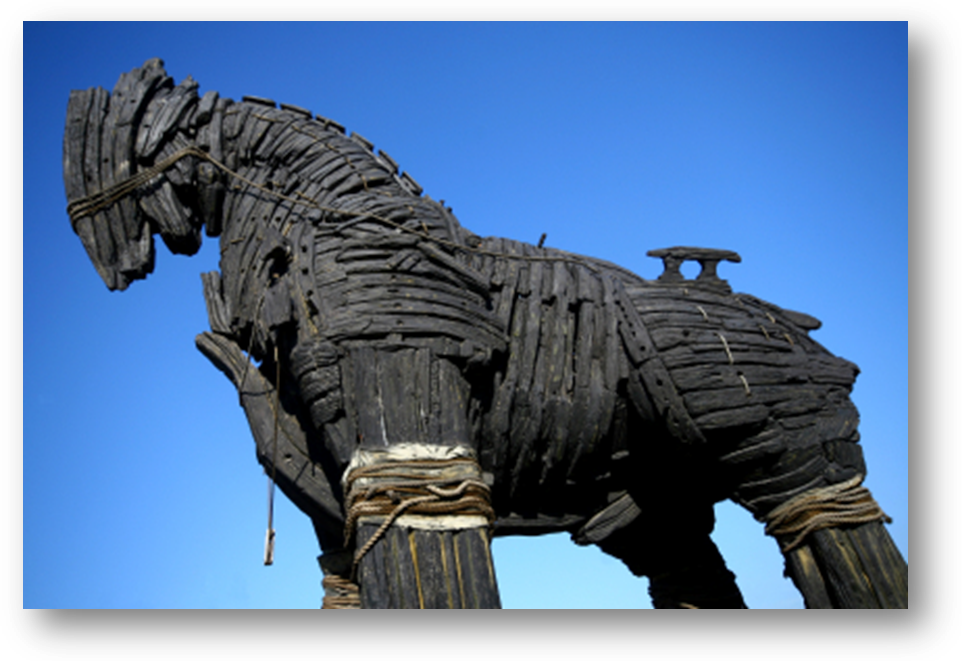
Sinon
said that the horse was made as an offering to Athena.† It was so huge because the Greeks didnít want
the Trojans to take it into the city.†
The Greeks hoped that the Trojans would destroy it so that it would draw
Athenaís anger upon Troy.† If it was
taken into the city, Athenaís favor would go to the Trojans and not the
Greeks.† Poseidon also helped with this
tale.† Poseidon didnít care for Troy.
The
priest Laocoon had been urgent with the Trojans to not keep the horse.† He said that he feared the Greeks, even when
they were bearing gifts.† Priamís
daughter, Cassandra, also echoed this warning.†
No one listened to her, however, and she returned to the palace before
Sinon was discovered.† Laocoon and his
sons heard Sinonís story and did not believe it.† Just as Sinon finished telling his story, two
large serpents arose from the sea.† The
serpents approached Laocoon and his two sons, wrapped themselves around them,
and crushed them.† The serpents then
disappeared.† To the other spectators,
there could be no doubt that Laocoon and his sons were punished for doubting
Sinonís story.†
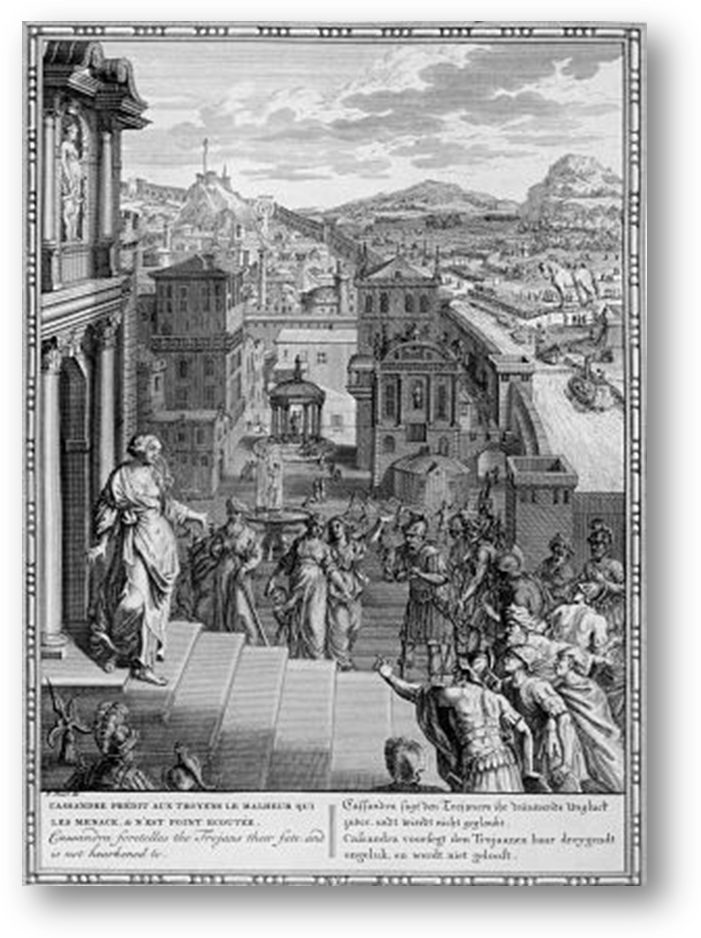
Cassandra Warns the Trojans
The
Trojans then dragged the horse through the gate and up to the temple of
Athena.† They began rejoicing, not only
for the end of the ten year battle, but also for the good fortune that was to
come to them from Athena.†
In
the middle of the night, the door in the horse opened.† One by one, the Greeks let themselves out of
the horse.† They went to the city gates,
threw them open wide, and let in the remainder of the Greek army.† Fires were started in buildings throughout
the city.† By the time the Trojans were
awake, they were struggling to put on their armor.† Troy was burning.† They rushed out onto the streets in states of
confusion.† Soldiers were waiting in the
streets for them, however, ready to strike them down when they exited their
homes.† Many died without having the
opportunity defend themselves.†
The
Trojans tried everything to defend themselves.†
They tore the tops off of houses and tried to throw beams down upon the
Greeks.† One of the towers of Priamís
castle was toppled over in an attempt to crush Greek soldiers.† Over the debris of the tower, the Greeks rushed
with a huge beam.† They battered at the
palace doors until the doors caved in.†
The Greeks were inside the palace before the Trojans could come down
from the roof.† Inside the courtyard, the
women and children had gathered with Priam, the King.† Achilles had previously spared Priam, but now
his son struck him down in front of his wife and daughters.
By
now, the end of the war was near.† Too
many Trojans had been killed in the beginning of this battle.† The Greeks could not be beaten back anywhere.† Slowly, the defense ceased.† Before morning, all of the Trojan leaders had
been killed except for one.† Aeneas,
Aphroditeís son, was the last Trojan standing.†
He had fought against the Greeks bravely.† Now, however, he could do nothing more for
Troy.† He hurried to his family, his old
father, little son, and wife.† As he went
to his family, Aphrodite appeared to him.†
She was urging him on and keeping him safe from the fires and the
Greeks.† Even with the help of his divine
mother, he could not keep his family safe.†
When the family fled their home, Aeneasí wife was separated from the
group and killed.† He was able to save
his father and his son.† He carried his
father on his shoulders and held onto his sonís hand.† He would not have been able to do this without
the help of Aphrodite.† She was the only
god who helped a Trojan that day.
Aphrodite
helped Helen as well.† She helped Helen
escape the city and took her to Menelaus.†
He received her gladly and the two of them set said for Greece together.
When
morning came, Troy was a fiery ruin.† All
that was left was a group of helpless women whose husbands had been killed in
battle.† Their children had been taken
from them.† They were waiting to be taken
overseas to a life of slavery. Among the women were Hecuba, the old queen, and
her daughter-in-law, Andromache.†
Andromache had been Hectorís wife.†
Andromache still had her son, Astyanax, with her.† A messenger from the Greek camp approached
Andromache and delivered bad news.† He
told Andromache that her son could not go with her.† Instead, Astyanax was to be thrown from the
wall of Troy.† Astyanax was carried away
from his mother by the Greeks.†
Before
the death of Astyanax, a young girl named Polyxena had been sacrificed on
Achillesí grave.† She was the daughter of
Hecuba.† With the death of Hectorís son,
Troyís last sacrifice was accomplished.†
The women waiting for the ships watched the end of their once great
city.
|
|
Now answer questions 1 through 29. |
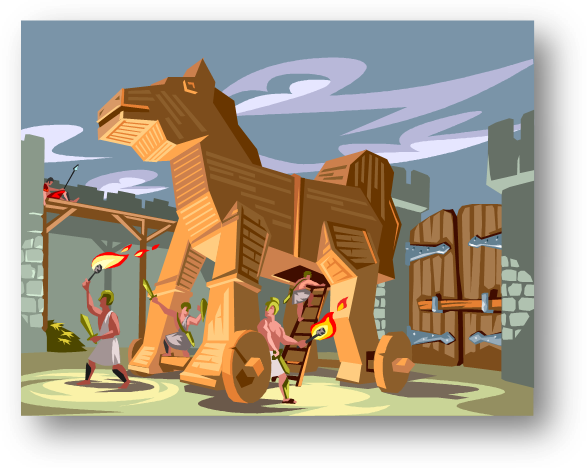
Rebuilding the Trojan Horse
The
following video clips detail a recent effort by Unsolved Histories to rebuild the Trojan Horse.† The goal was to determine whether or not the
horse actually could have existed and entered the city of Troy.† The videos also show a modern day group of men
attempting to stay inside the horse for an extended period of time like the
Greeks did.† Watch the video clips in
order to understand the project.
|
Constructing the Trojan Horse
(9:35) |
|
|
Selecting Men for Inside the Horse
(3:41) |
|
|
Moving the Horse into Position
(7:46) |
|
|
Men Tested inside of the Horse
(6:26) |
The
Trojan Horse also played a large role in the 2004 movie Troy.† The following video
gives a brief behind-the-scenes glimpse into the building of the Trojan Horse
on the set.
|
Building the Trojan Horse on the
Set of Troy (1:43) |
†
Writing about Literature
In
this unit, the story of the Trojan Horse was told.† Imagine that you were a Greek soldier who was
present for the last battle in Troy.† You
were inside the stomach of the horse on the night of this battle.† Write a letter home to your family, telling
them about the events of this night.†
Include details about planning ahead of time. Also include details about
the emotions you were feeling during this battle.† Your letter should begin with a salutation,
contain at least three paragraphs of 5 to 7 sentences each, and include a
closing.
To
begin your letter writing, complete one of the gathering information tasks
listed below.† The gathering information
tasks should generate important details about the story of the Trojan Horse,
including emotions.
|
Gathering Information Tasks |
|
|
Brainstorming |
A technique in which you come up
with as many ideas as possible on a subject |
|
Clustering |
A technique in which you break
down a subject into smaller parts Ė Place the subject in the middle and
circle it.† Write related ideas around
the subject, circling them and drawing lines to the subject. |
|
Asking
Questions |
A technique in which these
questions are used to gather information:†
Who?† What?† When?†
Where?† Why?† How? |
|
Direct
Observation |
A technique in which the writer
relies on the five senses Ė sight, touch, smell, hearing, tasting. |
|
Indirect
Observation |
A technique in which the writer
examines the experiences of others by asking questions, watching,
interviewing, etc. |
|
Imaging |
A technique in which the writer
uses his imagination to generate ideas |
Next,
compose your salutation and first paragraph.†
The salutation of your letter should greet the reader.† The first paragraph should introduce the topic
of the letter to the reader. You should also discuss the events of the Trojan
Horse myth in chronological order.
Then
compose the rough draft of the body of the letter.† Your rough draft should include two
paragraphs which contain important details about the Trojan Horse myth.† It should also include personal details such
as emotions and personal accounts of the evening.
Finish
the letter with a conclusion sentence.†
The conclusion sentence should bring the letter to a close. It should
leave the reader with a sense of closure.†
Your letter should end with a closing, such as Love, Sincerely,
etc.†
In
the questions section of this unit, you will be asked to self-evaluate your
work, revise, edit, and submit a final draft of your letter.
|
|
Now answer questions 30 through 36. |

MVP Project
You
have spent two units learning about the events of the Trojan War.† You have seen how the actions of many
different people and gods have changed the course of the war. Your task now is
to choose the person or god whom you believe had the biggest impact on the
events of the Trojan War.†
Create
an award for your Trojan War MVP.† You
may create a medal-style award, a trophy, a certificate, or any other type of
award. You must submit a digital copy of the award or a digital picture of the
award in the questions section. †Your
award will be evaluated using the following checklist.
|
c The award states the personís or
godís name. c The award clearly states why it is
being given. c The award is neat and organized. c The award uses correct spelling
and capitalization. c The award accurately reflects the
personís or godís contribution to the Trojan War. |
Along
with this award, you will present a two-minute speech presenting the award to
your MVP.† The speech should include some
basic background information about the personís or godís family,
accomplishments, and personality.† Then
explain the impact that your MVP had on the events of the Trojan War.† Keep in mind that the goal of this speech is
to honor your MVP.† You will record your
speech in the questions section. You will also be asked to submit a typed copy
of your speech.† Your speech will be evaluated
using the following checklist.
|
c The speech explains the personís
or godís family background. c The speech describes the personís
or godís accomplishments. c The speech describes the personís
or godís personality. c The speech clearly states why the
award is being given. c The speech explains the personís
or godís impact on the Trojan War. c The speech honors the chosen
person or god. c The ideas in the speech are
well-organized and easy to follow. c The speech is written and
delivered using formal language, not slang. c The speech is written and
delivered using complete sentences. c The student spoke slowly enough to
be understood. c The student spoke clearly enough
to be understood. c The studentís voice varied in
volume and speed throughout the speech. |
|
|
Now answer questions 37 and 38.
|
